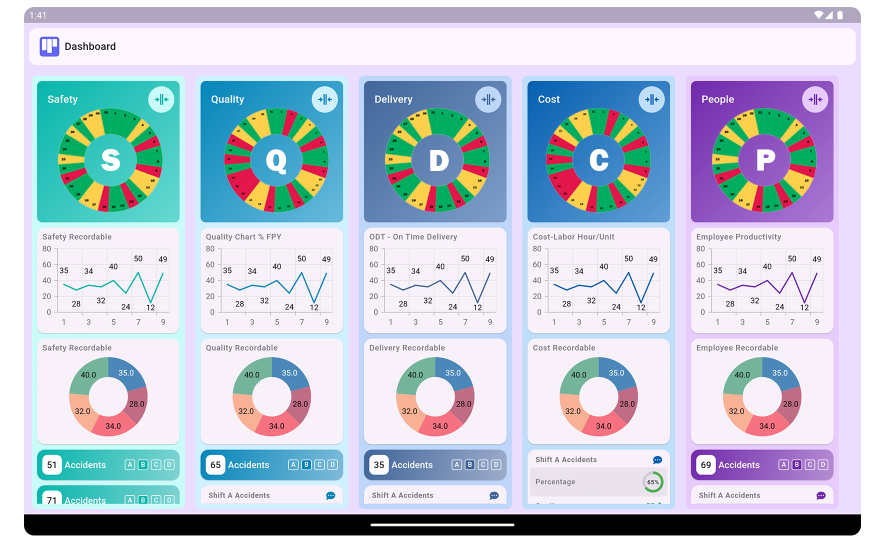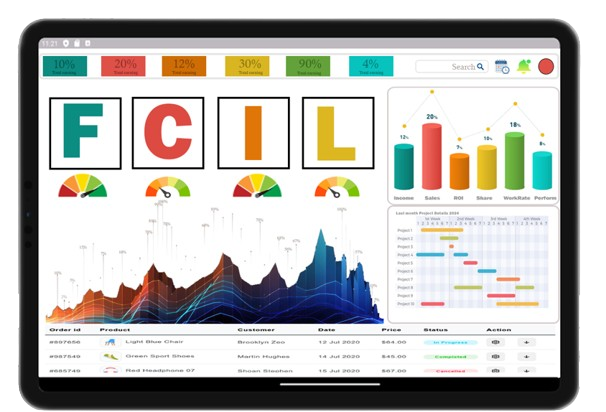The Digital Balanced Scorecard (DBSC) is a strategic management tool that enables organizations to translate their vision and strategy into actionable objectives and measurable outcomes. This modern iteration of the traditional Balanced Scorecard incorporates digital technologies to enhance performance tracking, data analysis, and strategic alignment.

Understanding the Digital Balanced Scorecard
The Balanced Scorecard was originally developed in the early 1990s as a framework for measuring organizational performance beyond traditional financial metrics. It provides a holistic view of performance through four perspectives: Financial, Customer, Internal Processes, and Learning and Growth. The Digital Balanced Scorecard builds upon this foundation by leveraging digital tools and technologies to enhance data collection, analysis, and reporting.
In a DBSC, organizations can incorporate real-time data from various sources, including enterprise resource planning (ERP) systems, customer relationship management (CRM) software, and other digital platforms. This integration allows for a more comprehensive and timely understanding of performance, enabling organizations to respond quickly to changes in their internal and external environments.
Key Components of the Digital Balanced Scorecard
There are several critical components of a Digital Balanced Scorecard:
- Objectives: Clearly defined strategic objectives are essential for guiding organizational efforts. These objectives should align with the overall vision and mission of the organization.
- Measures: For each objective, relevant performance measures should be established. These measures can include both quantitative and qualitative indicators that reflect progress toward achieving the objectives.
- Targets: Setting specific, measurable targets helps to define success and provides a benchmark for performance evaluation. Targets should be realistic yet challenging to encourage continuous improvement.
- Initiatives: Initiatives are the specific actions and projects undertaken to achieve the defined objectives. These initiatives should be prioritized based on their potential impact and feasibility.
- Data Integration: Digital technologies enable the integration of data from various sources, providing a comprehensive view of performance. This integration allows for real-time monitoring and analysis, facilitating informed decision-making.
- Dashboards and Reporting: Digital Balanced Scorecards often utilize dashboards to present performance data visually. These dashboards can provide stakeholders with easy-to-understand insights into performance across different perspectives.
Benefits of Implementing a Digital Balanced Scorecard
Organizations that adopt a Digital Balanced Scorecard can reap numerous benefits:
- Enhanced Strategic Alignment: The DBSC ensures that all organizational efforts are aligned with strategic goals, promoting coherence and focus throughout the organization.
- Improved Performance Monitoring: Real-time data integration allows organizations to monitor performance continuously, enabling quick identification of issues and opportunities for improvement.
- Data-Driven Decision Making: Access to accurate and timely data empowers leaders to make informed decisions based on current performance rather than relying on historical data.
- Increased Accountability: By defining specific objectives and performance measures, the DBSC promotes accountability at all levels of the organization, encouraging individuals to take ownership of their contributions.
- Continuous Improvement: The iterative nature of the DBSC encourages organizations to regularly review and adjust their strategies and initiatives based on performance data, fostering a culture of continuous improvement.
- Enhanced Communication: The visual representation of data through dashboards facilitates better communication of performance information among stakeholders, promoting transparency and understanding.
Implementing a Digital Balanced Scorecard Strategy
Implementing a Digital Balanced Scorecard requires careful planning and execution. Here are key steps to guide the process:
- Define the Vision and Strategy: The first step is to articulate the organization’s vision and strategic objectives clearly. This foundation will guide the development of the DBSC.
- Engage Stakeholders: Involve key stakeholders from various departments in the development process to ensure buy-in and gather diverse perspectives. This collaboration helps to create a more comprehensive and relevant scorecard.
- Identify Key Performance Indicators (KPIs): Select relevant KPIs that align with the strategic objectives. These indicators should provide insights into both leading and lagging performance.
- Develop Initiatives: Identify specific initiatives that will drive progress toward the established objectives. These initiatives should be actionable and prioritized based on their expected impact.
- Integrate Data Sources: Establish a framework for integrating data from various systems to ensure accurate and timely reporting. This integration is crucial for real-time performance monitoring.
- Create Dashboards: Develop user-friendly dashboards that visually represent performance data. Ensure that these dashboards provide relevant information tailored to different stakeholders’ needs.
- Communicate and Train: Effectively communicate the purpose and benefits of the DBSC to all employees. Provide training to ensure that users understand how to leverage the system effectively.
- Review and Adapt: Regularly review the performance data and the effectiveness of the DBSC. Be prepared to adapt the strategy and initiatives based on insights gained from the data.
Best Practices for Maximizing the Effectiveness of a Digital Balanced Scorecard
To ensure the success of a Digital Balanced Scorecard strategy, organizations should consider the following best practices:
- Keep It Simple: Focus on a manageable number of objectives and KPIs to avoid overwhelming stakeholders. Simplicity ensures clarity and enhances usability.
- Ensure Continuous Engagement: Foster ongoing engagement with stakeholders by regularly updating them on performance and involving them in the review process. This engagement promotes accountability and a sense of ownership.
- Leverage Technology: Utilize digital tools and technologies to automate data collection and reporting processes. This automation reduces manual effort and enhances data accuracy.
- Encourage a Culture of Learning: Promote a culture that values learning and improvement. Encourage teams to analyze performance data, identify areas for growth, and celebrate successes.
- Align Performance with Rewards: Consider linking performance outcomes to rewards and recognition programs. This alignment incentivizes employees to strive for excellence in achieving strategic objectives.
Digital Balanced Scorecard Strategy
What is a Digital Balanced Scorecard Strategy?
A Digital Balanced Scorecard Strategy is a performance management tool that translates an organization's vision and strategy into a coherent set of performance measures, integrating digital technologies for real-time tracking and analysis.

How does a Digital Balanced Scorecard differ from a traditional Balanced Scorecard?
While both frameworks focus on performance measurement, a Digital Balanced Scorecard leverages technology for real-time data collection, visualization, and reporting, enabling quicker adjustments and more informed decision-making.
What are the key components of a Digital Balanced Scorecard?
The key components include financial performance, customer satisfaction, internal processes, and learning and growth, along with digital tools for tracking and analyzing these metrics effectively.
How can organizations benefit from implementing a Digital Balanced Scorecard?
Organizations benefit from improved strategic alignment, enhanced performance visibility, better decision-making, and the ability to adapt quickly to changing market conditions through real-time insights.
What role do KPIs play in a Digital Balanced Scorecard Strategy?
Key Performance Indicators (KPIs) are essential for measuring progress toward strategic goals, providing quantifiable metrics that help organizations assess performance in each of the scorecard's components.
How is data collected and analyzed in a Digital Balanced Scorecard?
Data is collected through integrated digital systems that track performance metrics in real time, allowing for ongoing analysis and immediate adjustments to strategies as needed.
What tools are typically used in a Digital Balanced Scorecard Strategy?
Tools can include dashboard software, analytics platforms, data visualization tools, and project management applications that facilitate the tracking and reporting of performance metrics.
Can a Digital Balanced Scorecard be customized for different industries?
Yes, it can be tailored to fit the specific needs and strategic goals of various industries, ensuring that the KPIs and metrics are relevant to the organization’s unique context.
How does a Digital Balanced Scorecard enhance decision-making?
By providing real-time data and insights, a Digital Balanced Scorecard empowers leaders to make informed decisions quickly, allowing for timely adjustments to strategies and operations.
What challenges might organizations face when implementing a Digital Balanced Scorecard?
Challenges include resistance to change, data integration issues, the need for staff training, and ensuring consistent measurement across various departments and units.
How often should a Digital Balanced Scorecard be reviewed and updated?
It should be reviewed regularly—typically quarterly or biannually—to ensure that the metrics remain aligned with strategic goals and reflect any changes in the business environment.
What is the significance of aligning the Digital Balanced Scorecard with strategic goals?
Aligning the scorecard with strategic goals ensures that all metrics are relevant and focused on driving the organization toward its objectives, enhancing overall performance and accountability.
How does a Digital Balanced Scorecard support continuous improvement?
It promotes continuous improvement by enabling organizations to track performance trends, identify areas for enhancement, and implement data-driven strategies for ongoing development.
What training or resources are available for teams implementing a Digital Balanced Scorecard?
Resources may include workshops, online courses, manuals, and access to expert consultants who can guide teams through the implementation and optimization of the strategy.
How can organizations get started with a Digital Balanced Scorecard Strategy?
Organizations can start by defining their strategic goals, selecting relevant KPIs, choosing appropriate tools, and involving key stakeholders to ensure a comprehensive implementation process.